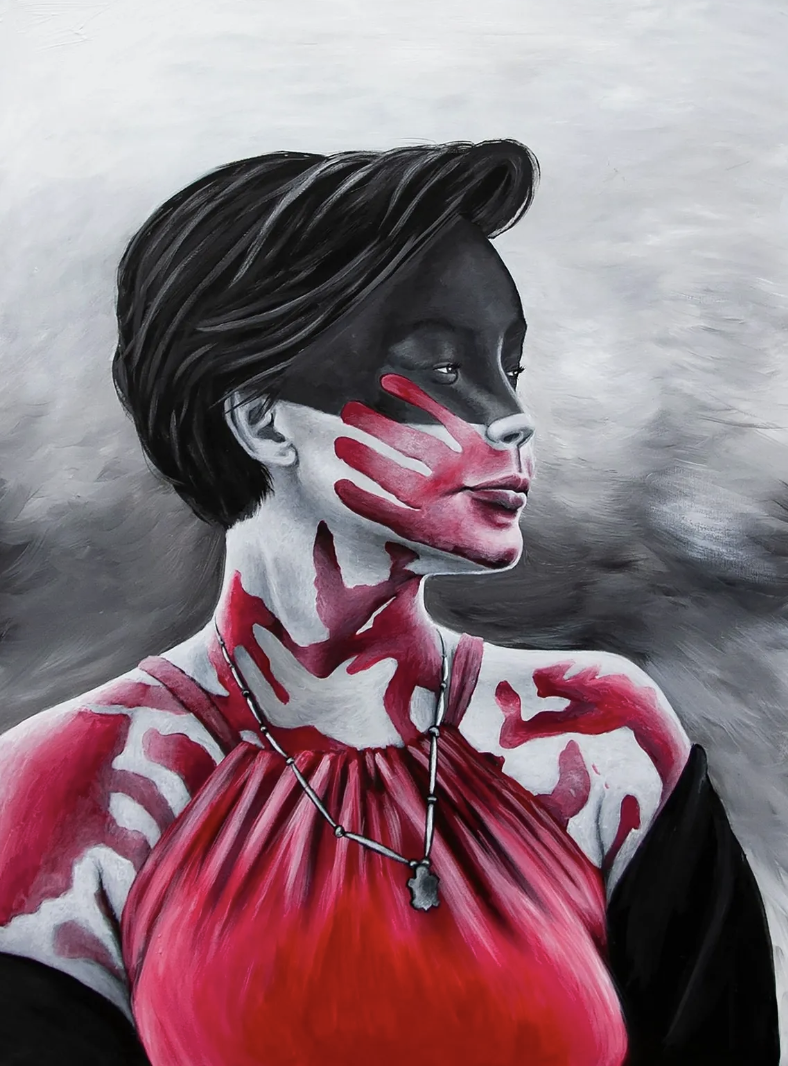
- Details
- By Native News Online Staff
The Museum at Warm Springs announced on Wednesday that it will host “Portraits in Red: Missing &; Murdered Indigenous People Painting Project,” a national traveling exhibition beginning on June 5, 2024.
The exhibition will be on view from then until Saturday, September 7, 2024.
“Portraits in Red: Missing & Murdered Indigenous People Painting Project” features 40 paintings by Nayana LaFond (Metis Nation) that focus on the Missing and Murdered Indigenous Relatives epidemic that is prevalent in Indian Country.
Behind each of the paintings is the voice of an Indigenous person who has suffered the impact of violence. Ninety-eight percent of Native people experience violence during their lifetime. Native women face murder rates 11 times the national average. These crimes are under-reported by the media and under-prosecuted by law enforcement.LaFond’s project brings visibility to this ongoing epidemic.
LaFond’s painting project began in 2020 with one painting, “Lauraina in RED,” created for the National Day of Awareness for Missing and Murdered Native Women and Girls, which is observed on May 5 and now known as Missing and Murdered Indigenous Persons Awareness Day.
Since 2020 she’s painted more than 50 commissioned portraits. As of February 2024, there were 110 completed paintings. Every portrait is of someone who is missing, was murdered, survived, a family member or friend, or an activist/hero fighting for the cause. LaFond hopes to make sure the missing and dead are never forgotten, to raise awareness about this serious issue, and to provide help with healing to the families.
LaFond is a full-time multidisciplinary artist and activist who resides with her child in Western Massachusetts. She attended Greenfield Community College for Fine Art and Massachusetts College of Art for Photography and then dropped out to become a full-time painter.
Her paintings and sculptures can be seen in galleries and museums around the world. Her project, “Missing & Murdered Indigenous People Painting Project,” has gained her international acclaim and is currently on display in museums around North America, including a Pacific Northwest Coast tour, a tour through the Institute of American Indian Studies Museum and more. LaFond has also been a curator and community arts organizer for more than 20 years, including serving as the former founding chief curator for The Whitney Center for the Arts (Pittsfield, Mass.). She also sits on the boards of several arts organizations, including as executive board member of Artist Organized Art in New York City. LaFond is a citizen of the Métis Nation of Ontario, Canada.
More Stories Like This
Vision Maker Media Honors MacDonald Siblings With 2025 Frank Blythe AwardFirst Tribally Owned Gallery in Tulsa Debuts ‘Mvskokvlke: Road of Strength’
Zuni Youth Enrichment Project and Partners at Ho’n A:wan Productions Launch 8th Annual Delapna:we Project
Chickasaw Holiday Art Market Returns to Sulphur on Dec. 6
Center for Native Futures Hosts Third Mound Summit on Contemporary Native Arts
Help us defend tribal sovereignty.
At Native News Online, our mission is rooted in telling the stories that strengthen sovereignty and uplift Indigenous voices — not just at year’s end, but every single day.
Because of your generosity last year, we were able to keep our reporters on the ground in tribal communities, at national gatherings and in the halls of Congress — covering the issues that matter most to Indian Country: sovereignty, culture, education, health and economic opportunity.
That support sustained us through a tough year in 2025. Now, as we look to the year ahead, we need your help right now to ensure warrior journalism remains strong — reporting that defends tribal sovereignty, amplifies Native truth, and holds power accountable.
 The stakes couldn't be higher. Your support keeps Native voices heard, Native stories told and Native sovereignty defended.
The stakes couldn't be higher. Your support keeps Native voices heard, Native stories told and Native sovereignty defended.
Stand with Warrior Journalism today.
Levi Rickert (Potawatomi), Editor & Publisher


